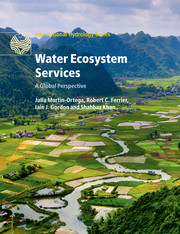Book contents
- Frontmatter
- Contents
- List of contributors
- Preface
- 1 Introduction
- 2 What defines ecosystem services-based approaches?
- Part I Addressing global challenges
- Part II Applying frameworks for water management and biodiversity conservation under an ecosystem services-based approach
- Part III Assessing water ecosystem services
- Part IV Broadening the perspective
- 15 Ecosystem services-based approaches to water management: what opportunities and challenges for business?
- 16 Key factors for successful application of ecosystem services-based approaches to water resources management: the role of stakeholder participation
- 17 Cultural ecosystem services, water, and aquatic environments
- 18 The psychological dimension of water ecosystem services
- 19 The interface between human rights and ecosystem services
- 20 Water ecosystem services: moving forward
- Index
- Plate Section
- References
16 - Key factors for successful application of ecosystem services-based approaches to water resources management: the role of stakeholder participation
from Part IV - Broadening the perspective
Published online by Cambridge University Press: 05 May 2015
- Frontmatter
- Contents
- List of contributors
- Preface
- 1 Introduction
- 2 What defines ecosystem services-based approaches?
- Part I Addressing global challenges
- Part II Applying frameworks for water management and biodiversity conservation under an ecosystem services-based approach
- Part III Assessing water ecosystem services
- Part IV Broadening the perspective
- 15 Ecosystem services-based approaches to water management: what opportunities and challenges for business?
- 16 Key factors for successful application of ecosystem services-based approaches to water resources management: the role of stakeholder participation
- 17 Cultural ecosystem services, water, and aquatic environments
- 18 The psychological dimension of water ecosystem services
- 19 The interface between human rights and ecosystem services
- 20 Water ecosystem services: moving forward
- Index
- Plate Section
- References
Summary
16.1 INTRODUCTION
Ecosystem services-based approaches for water resources management may help to select and engage with stakeholders whose interests are affected by any changes in their water environment (Blackstock et al., this book). In addition, Brauman et al. (2014) state that the notion of ecosystem services provides a framework for organizing stakeholders, identifying those whose actions affect the provision of river basin ecosystem services and those whose wellbeing will be impacted by changes in the provision of ecosystem services, and by delineating the mechanisms by which land use changes affect stakeholders. Furthermore, ecosystem services may also be a common language to facilitate communication with, and thus participation of stakeholders. It seems to offer an easy language to communicate their positions and interests and to identify common interests (Brils et al. 2014). Some results from regional case studies are already available that confirm this expectation (e.g. Granek et al. 2009; van der Meulen & Brils 2011; van der Meulen et al. 2013). But what are key factors for the successful application of ecosystem services-based approaches to water resources management? This chapter aims to identify some of these key factors with a focus on stakeholder participation.
We start by analysing the application of the ecosystem services-based approaches in the Catskill watershed management in the USA as this is probably one of the best practical examples known of successful application. The key success factors are extracted from this case study and their applicability to Northern Europe – the ‘River Tamar’ case in the UK and the ‘Farmers around Amsterdam as Water Managers’ case in the Netherlands – is discussed. This chapter serves as an illustration of the stakeholder participation aspects of core element 3 (transdisciplinarity) of this volume.
16.2 CATSKILL WATERSHED MANAGEMENT (USA)
16.2.1 Issues at stake
The Catskill watershed protection programme was a response by the city of New York to one of its most prized infrastructure assets, the pure, unfiltered water of the Catskill Mountains (Figure 16.1) that flows to New York City through a long series of aqueducts, representing the engineering vision of generations of water managers.
- Type
- Chapter
- Information
- Water Ecosystem ServicesA Global Perspective, pp. 138 - 147Publisher: Cambridge University PressPrint publication year: 2015
References
- 3
- Cited by

